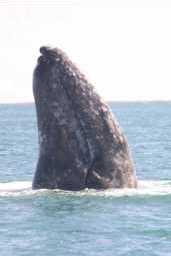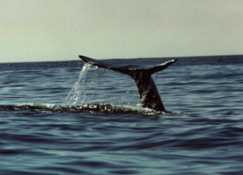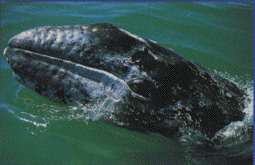Gray Whale Numbers Shrink by Thousands |
 Gray Whales in Guerrero Negro Mexico - Photo by Arturo Guerra Perez |
Whale Population Still Threatened
By Eric Sorensen - Seattle Times science reporter
The population of Eastern North Pacific gray whales has dropped in the past four years from an estimated high of more than 26,000 to less than 18,000, alarming environmentalists but drawing no major concern from federal scientists who monitor the once-endangered whales.
Environmentalists see the drop as a sign that the whale's population is still threatened by hunting, pollution, climate change and dwindling food supplies.
"If these numbers are correct, it's a very dramatic, very sharp decline in a short time period," said Michael Markarian, executive vice president of the Fund for Animals, which was in federal court this week, trying to stop the Makah tribe from hunting the whales.
A federal judge yesterday rejected activists' call for a halt to Makah whaling until their lawsuit challenging the hunt is resolved. Judge Franklin Burgess also said the plaintiffs had not proven "irreparable injury" would occur if the hunts proceeded.
Scientists suspect the gray-whale population dropped because of low food supplies in the whales' Arctic feeding grounds and predict the numbers will rise again next year.
Moreover, the latest drop is a fluctuation - one that you would expect from a population that has rebounded so well that it is now at the limit of what the environment can sustain, said Paul Wade, a marine biologist for the National Marine Fisheries Service's Sand Point-based National Marine Mammal Laboratory.
"In our mind, it's one of the big success stories," Wade said.
 Gray whale tail - Photo by Francesca di Rienzo |
The Eastern North Pacific gray, a 30-ton behemoth with an epic migration of up to 11,000 miles, was nearly hunted to extinction in the 19th century by Yankee whalers and numbered only a few thousand at the beginning of the 20th century. But in the past two decades, its population has often topped 20,000. The 1997-1998 estimate of 26,700 is often quoted as the current population but that number has decreased since then.
The figure is calculated by counting whales as they migrate southward from Alaska to Mexico past Central California between December and February. But the counts have to be adjusted to account for whales passing at night, times when they can't be easily seen from shore, their distances from shore and other factors.
Dave Rugh, wildlife biologist and project leader of the gray-whale census for the Marine Mammal Lab, said the recent population estimate of 17,414 has enough wiggle room that it actually could be as low as 14,322 and as high as 21,174. Still, that high number does not overlap with the low margin of the 1997-1998 estimate, so the change is considered statistically significant.
"That's a pretty big shift," he said.
Rugh said 1998 saw a "warm-water event" around Alaska that hurt the whales' food supply. Both 1999 and 2000 had more than 300 dead whales seen and reported on the migration route, suggesting many more also died.
Wayne Perryman, a fisheries biologist who monitors calf production out of the NMFS Southwest Fisheries Science Center in La Jolla, Calif., said calf production also dropped from 1,388 calves in 1998 to 427 and 280 in the following two years. He suspects this is because heavy ice kept pregnant whales from their feeding areas in the summer before their winter births off Baja Peninsula.
 Gray whale head |
The number of strandings has since dropped dramatically, leading researchers to believe the whales' population will soon go back up. Perryman also saw less ice last summer and higher calf numbers this spring.
There may even be some whales who missed getting counted because low food supplies up north prompted them to stay in their southern waters, Wade said.
Still, the population drop bolsters the argument for placing the whales back on the endangered-species list, said Markarian of the Fund for Animals. The whale was placed on the endangered-species list in 1970 and removed in 1994, but the Fund for Animals last year petitioned to have the animal relisted.
Anti-whaling activists also have argued that the whale's delisting was premature. The new figure added to their concern, said Charlotte de Fontaubert, oceans-campaign coordinator for Greenpeace.
"Seventeen-thousand is a very low figure indeed and quite worrisome," she said.
NMFS last week presented the new population figure to the International Whaling Commission's scientific committee. By Wade's analysis, aboriginal subsistence hunters could now take 463 whales a year. That is almost as many as the limit of 482 approved by the commission in 1997.
The International Whaling Commission received the analysis when it convened in Shimonoseki, Japan.
Eric Sorensen can be reached at 206-464-8253 and esorensen@seattletimes.com
SEATTLE, 18 May, 2002
http://seattletimes.nwsource.com/html/localnews134456838_graywhales18m.html
Copyright © 2002 The Seattle Times Company